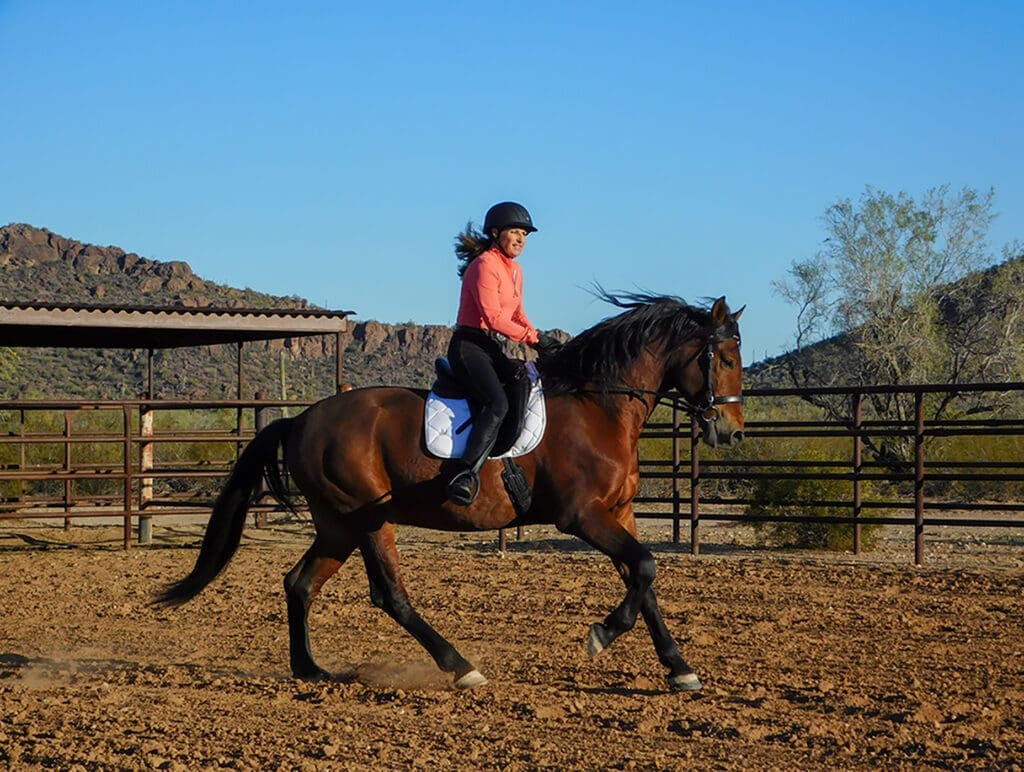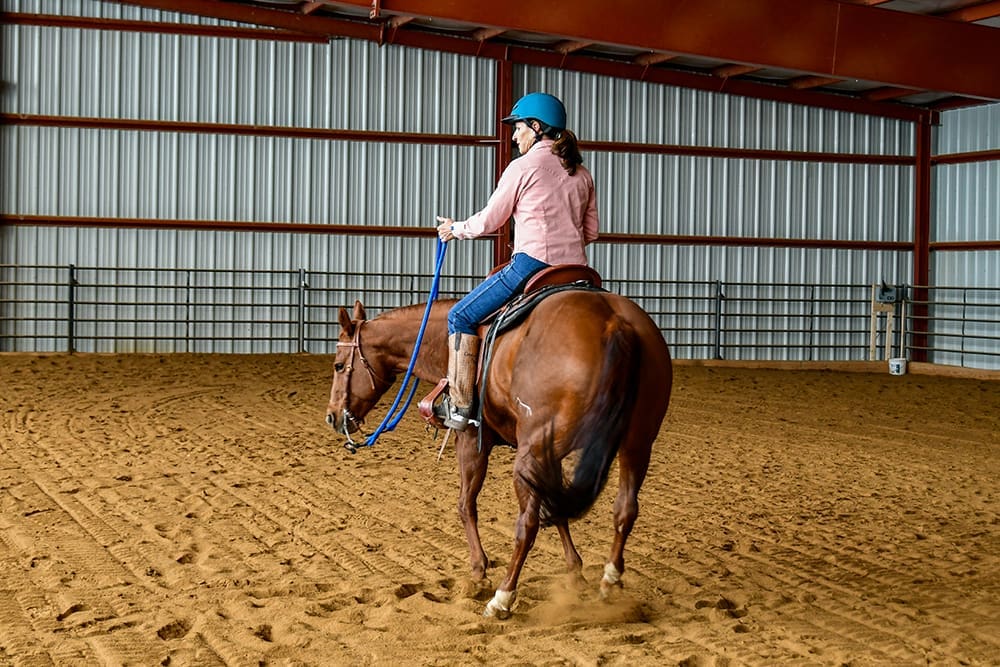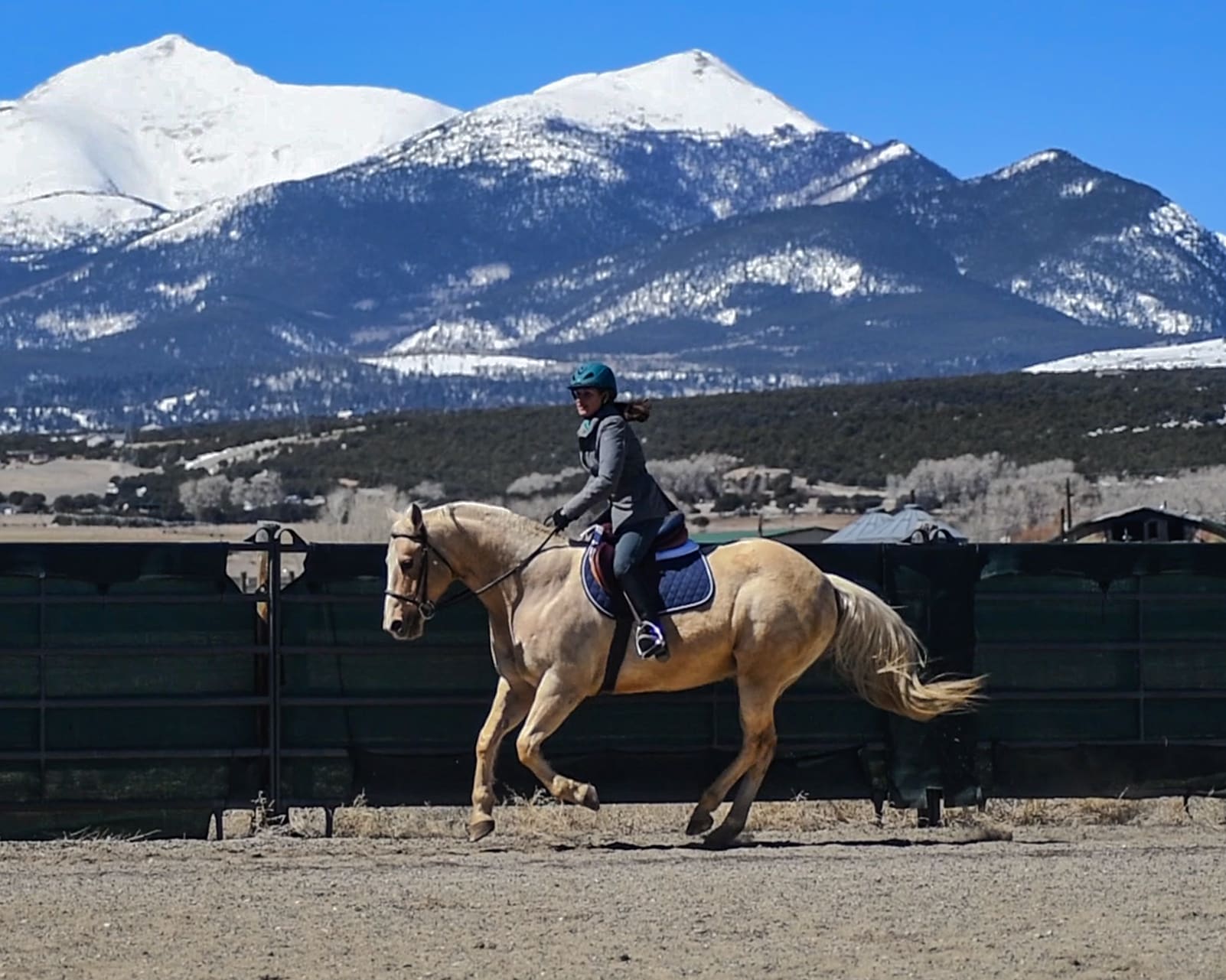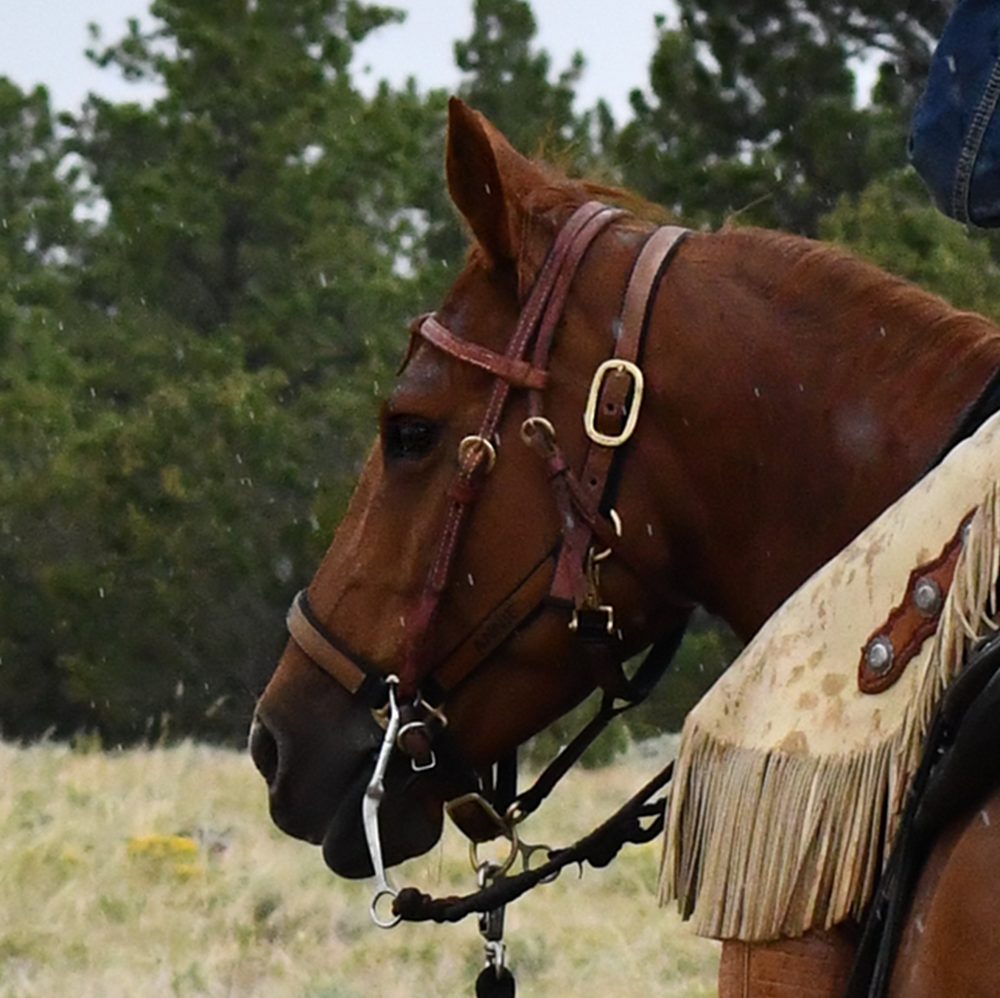
Five Canter Hacks for Green Horses and Green Riders
The natural gaits of the horse are walk, trot and gallop. The canter is a slow, collected gallop, developed over time, through training. Rarely do you look out into a pen full of horses and see them making slow bendy circles at the canter. Instead, they prefer to run full speed straight ahead, then drop their shoulder, wheel around, and take off in the other direction. Balancing the rider enough to canter slowly and arc turns at the canter, comes with time and training.
Canter and lope mean the same thing. Canter is the more traditional term and lope is a slang term used in Western riding, derived from the Spanish word gallope. Whether you ride English or Western, learning to sit the canter smoothly and control the horse’s direction and speed is a goal of most riders, even though it is a gait that can be intimidating to ride.
Whether you’re just starting out and learning to ride the canter for the first time, an experienced rider dealing with a loss of confidence, or an advanced rider training a green horse, these hacks are for you! I’ll discuss some of the most common canter problems I see in less-experienced riders and green horses, I’ll give you some quick fixes, and I’ll share some horsemanship secrets that you may not know. It’s not likely that you’ll need all these hacks, but it is likely that at least one of them will help propel you and your horse to a higher level.
#1 Confidence to Canter
There’s an old saying in horsemanship (thousands of years old, in fact) that says, “The best way to improve canter is to improve the trot.” This simply means that if you wait to canter until you have truly mastered the trot, cantering will be easy. The trot is actually a harder gait to ride, with a lot of vertical motion that tends to throw you up and out of the saddle.
There is a lot to accomplish at the trot: you can ride it sitting, posting, and standing; none of which are easy. You can ride a working trot, collected trot, extended trot. You can ride changes of direction, circles, serpentines and execute many maneuvers at the trot. I encourage riders not to get in a big hurry to canter. It will be much easier when you’ve mastered the trot.
When riders approach the canter with trepidation, the horse will read the reluctance of the rider and be reluctant to canter himself. Most horses have learned the hard way that when a rider is reluctant, they usually get hit in the mouth in the canter departure. He doesn’t want to canter anyway, so if the rider is not committed, the horse will not be either.
It’s best to wait to tackle the canter until you’re ready to commit and you want it! Work on your skills and confidence at slower gaits. I offer a short course on developing confidence, which may help you address your fears, so that you come to cantering with the right mindset.
#2 Sitting the Canter
If you’re just learning to canter, it’s hard to know what to teach you first—how to get the horse into the canter or how to ride the gait when he does canter. It’s an awkward stage! I prefer to set the student’s horse up to canter in the easiest way possible so that the rider can focus on sitting the gait first.
To sit the canter smoothly, your hips make a circle—forward and down, up and back, like they do when you push a swing to go higher. There’s a moment in the stride, when the horse goes into complete suspension (all four feet are off the ground), when your shoulders go behind your hips—if you are sitting back far enough.
The biggest mistake I see in riders learning to canter is that they sit too far forward and the lift in the horse’s back throws them up and out of the saddle in a posting motion. Therefore, I encourage riders learning to sit the canter to lean back, with your shoulders slightly behind your hips. But make sure you reach forward with your hands as he starts, so you don’t accidentally hit him in the mouth when he departs.
One of the easiest ways to learn to canter is out on the trail, with steady horses in front of and behind you, on a flat sandy surface. With good communication and more experienced riders supporting you, it will be easy to get the horse into the canter and you can focus on the feel of it without having to steer.
My number one selling training video is Canter with Confidence, and it can be especially useful in learning to ride the canter smoothly and it thoroughly covers how to cue the horse for canter and how to get the correct lead.
#3 Controlling Direction
Riding straight lines at the canter is far easier than riding turns. In the arena, horses tend to drop their shoulders, cut corners, and lean into the middle. It’s what horses do, and these natural tendencies are often exacerbated by the rider.
Often, when a rider is learning to control the horse at the canter, the horse breaks gait as soon as a turn is attempted. The rider leans into the turn, throwing the horse off balance and into the middle, then the rider pulls back on the rein to turn, instead of opening the rein to the side. The backward pull equals opposition to forward movement and causes the horse to break gait. In this common scenario, the rider’s errors are causing the horse to canter fast and out of balance, and rider error trains the horse to break gait.
Set up a cantering scenario where you can canter a long straight line at first, then come back to a controlled trot before you make a turn. Once you can ride the straight lines and upward and downward transitions well, then think about tackling turns. But first, you must conquer the straight line on the long wall, with balanced upward and downward transitions. Your next goal in the arena for controlling the canter is being able to canter around the short side and past the gate, without breaking gait; then all the way around the arena.
Be aware! There’s a fine line between a rider learning to control the canter and a trained horse being disobedient. If the horse is refusing, shutting down, diving into the middle, or slamming on the brakes at the gate, you may be dealing with disobedience. If so, go back to walk and trot and regain your authority. Address the disobedience before coming back to the canter, but keep in mind this kind of disobedience is often a result of a horse’s frustrations over the rider’s mistakes and may lead to worse behavior if the mistakes of the rider are not addressed.
#4 Controlling Speed
Green horses cannot canter slowly—that is a skill that is learned over time. Young horses will usually need to carry a little speed because sometimes balance requires speed. Some horses are more talented in this area than others. In my experience, people often complain about their horses going too fast at the canter when the horse is actually moving well. If the horse is green, you may have to accept a little speed.
One thing I know for sure, you cannot control speed by pulling on the reins. Pulling on two reins to make the horse go slower at the canter will almost always result in the horse going faster and “running throughout the bridle.” This is a ridiculously hard concept to comprehend for novice riders, but often the horse will slow down when you loosen the reins.
For me, the two most effective means for slowing the canter is first to put the horse on a wide arcing circle. Lift slightly up and in with your inside rein and energize and lengthen your inside leg, so the horse lifts his inside shoulder and tips his nose into the circle. Gradually bring the horse onto a smaller circle, with a lot of bend in the horse’s body—which will physically cause him to slow down. As soon as you feel the horse gear down, release him from the circle on a loose rein. Gradually, through circling and bending, the horse develops better balance and coordination and learns that going slower is easier and gets him what he wants.
Another useful hack to slow down the canter is with trot-canter-trot-canter transitions. Start by just cantering 3-4 strides, then coming back to a slow, collected trot. After many repetitions of that, start going 5-6 strides, then 6-8 strides, always coming back to a slow collected trot. Soon the horse begins to anticipate the downward transition, so he prepares by going slower. This is a classic example of “replacement training,” a highly effective means of training horses, where you replace one thought or behavior with another. Soon, every time he speeds up, he will think about slowing down.
These training lessons are also a part of my online training course, Goodnight Academy, which offers a complete curriculum of groundwork, equitation lessons and horse training, and personalized coaching from me.
#5 Breaks Gait
Which brings us to another common problem, mostly caused by the rider—breaking gait. It’s a cardinal disobedience for the riding horse and it may Illuminate a hole in the horse’s fundamental training, a lack of authority from the rider, or gross errors of the rider that impede the horse’s ability to continue the canter. The latter is often the cause of the aforementioned frustration in the horse (see #3).
If the horse also breaks gait at the trot and walk, the horse is lacking basic training, or the rider has no authority, or both. For thousands of years, we’ve known that forward motion is the basis of all training in the horse; without it, the horse cannot be trained. A properly trained and obedient riding horse continues at the speed set by the rider, until the rider cues the horse to speed up, slow down or stop. If the shoe fits, go back to basics and come back to the canter once it’s resolved at the walk and trot.
Horse often learn to break gait simply because the rider allows and condones it. Most horses don’t want to keep cantering circles with a rider on their back. If the horse breaks into trot, most riders politely re-cue the horse to canter, as if breaking gait was not a problem. But the disobedience continues indefinitely because the horse benefits from breaking gait (rest) and pays no penalty. Re-cueing to canter, without admonishment or ramifications, tells the horse that you condone his breaking gait.
If the horse breaks gait at the canter, give him a good scolding, with your voice and other aids, to let him know you disapprove. Then put him immediately back to canter and make him work harder for a 10-20 strides. If you feel the horse starting to falter in his stride, drive him forward into a hand gallop and only let him stop and rest when you feel him moving freely forward. If you only stop the horse when he is moving forward willingly, he’ll stop breaking gait.
Don’t Worry, You’ll Get There!
The canter is the most complicated of gaits to learn to ride and it takes time to develop good skills in both the horse and the rider. In a perfect world, people learning to canter would only ride easy, well-trained horses, and untrained horses would only be ridden by high-level, experienced riders, but that’s not always how it goes.
Whether you’re just learning to canter for the first time or you are training a green horse, I hope you found some help with the canter hacks listed here. Tackle your issues one at a time—start with the most basic and work toward the more complex skills. Give it time and practice deliberately. Get help from an instructor or a more experienced rider, so you have some external feedback.
Next month, I’ll give you five more canter hacks for the more experienced horse and rider, working to perfect the canter. We’ll look at how to keep the horse from dropping his shoulder in turns, how to deal with the horse that trots faster instead of stepping smoothly into canter, preventing bucking, perfecting canter departures, and collecting the canter.
Until then, enjoy the ride!



